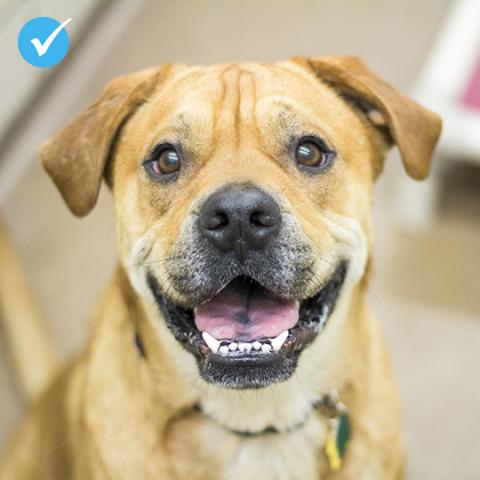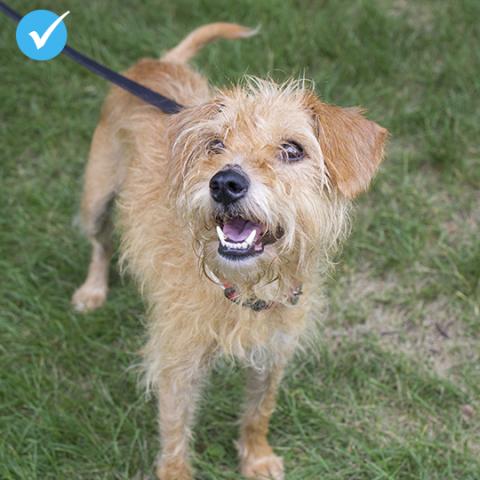Whether it’s a simple walk around the block, an outing to a public patio, or an adventure of another kind, ensure your pooch is ready to meet people while on leash.
To train your dog to politely greet others, there are two things to keep in mind:
- Your dog must be comfortable with the situation and want to meet people. Like people, dogs have moments when they don't want to say hello to strangers, or even friends. They may be tired, feel ill, or just want to get to the park.
- Your dog should be taught the proper way of greeting people by keeping all four paws on the ground, and avoiding jumping or lunging. This allows you to better observe their body language, and more easily move them away if they're feeling uncomfortable.
See if your dog is open to a greeting
A simple way to test your pup’s openness to meeting others is to have a friend or family member approach you and your dog. Allow for a few feet between the dog and person, and take a moment to observe the following:
- Is your dog's body loose and wiggly, or tense with little movement?
- Is your dog's mouth open or closed?
- Is your dog moving toward the person or away from them?
- Is your dog looking at the person or looking away from them?
Dog body language examples
To help answer the questions above, check out these examples of what to look for in your dog.
Relaxed and friendly signals

Open, smiley mouth

Tail wagging loosely

Semi-closed, squinty eyes

Leaning toward person
If your dog is showing any of these behaviors — their body is loose and wiggly, their mouth is open and relaxed, they’re moving or leaning toward the person — they’re ready to meet the other person. Let them greet the person and make a new friend!
Other signs your dog is comfortable and ready to make friends include:
- Relaxed, neutral ears
- Loosely-moving body
- Bottom wiggling
Signs of discomfort and needing space

Licking lips, ears back

Mouth closed, still body

Brow furrowed

Head turned
If your dog is showing any of these signs of stress, they’re not comfortable with the other person and shouldn’t greet them at that time.
Other signs your dog is introverted and stressed include:
- Base of tail is lower than spine
- Lifted paw
- Yawning
- Dilated pupils
- Rolling over
Help your dog if they’re stressed
Even if your dog isn’t yet ready to meet someone on their own, you can help your dog and the other person feel more comfortable and ready to meet with a few simple steps.
- Move between your friend or family member and your dog to stop their approach.
- Explain your dog is in training or needs a little space.
- Feed your dog treats as needed.
- Have your friend or family member toss you dog treats to help build trust while maintaining a few feet of distance.
- Show and tell how your dog likes to be pet, then have your friend or family member give it a try as your dog relaxes.
- Tell your friend or family member to only pet the dog when their paws are all on the ground — not when jumping or lunging.
- Reward your dog for four paws on the ground. Don’t give treats when all four paws aren’t on the ground. To encourage this behavior, try scattering treats on the ground or holding a handful of treats on your dog's nose to manage jumping.
Signs of distress

Tail tucked

Body appears stiff

Stiff body, eyes dilated

Eyes dilated and direct stare
If your dog displays any of the following behaviors — tail tucked, dilated eyes, stiff posture, or a direct stare — don't let the person approach. Give your dog the space and time it needs to get comfortable with the situation.
Understanding dog tolerance and reactivity
Does your dog's body language shift around other dogs? Learn more about dog tolerance and reactivity.
Other signs that your dog needs some space include:
- Tail is tucked between legs or high over the back
- Hair is standing on end
- Growling
- Barking
- Hiding behind you
- Avoiding physical contact
- Whites of eyes showing
Learn more about pet behavior
For more tips and tricks to bring out the best in your best friend, visit our Pet Behavior Library. You can also call our Pet Helpline at 952-435-7738 for helpful advice from a trainer or behavior specialist.



